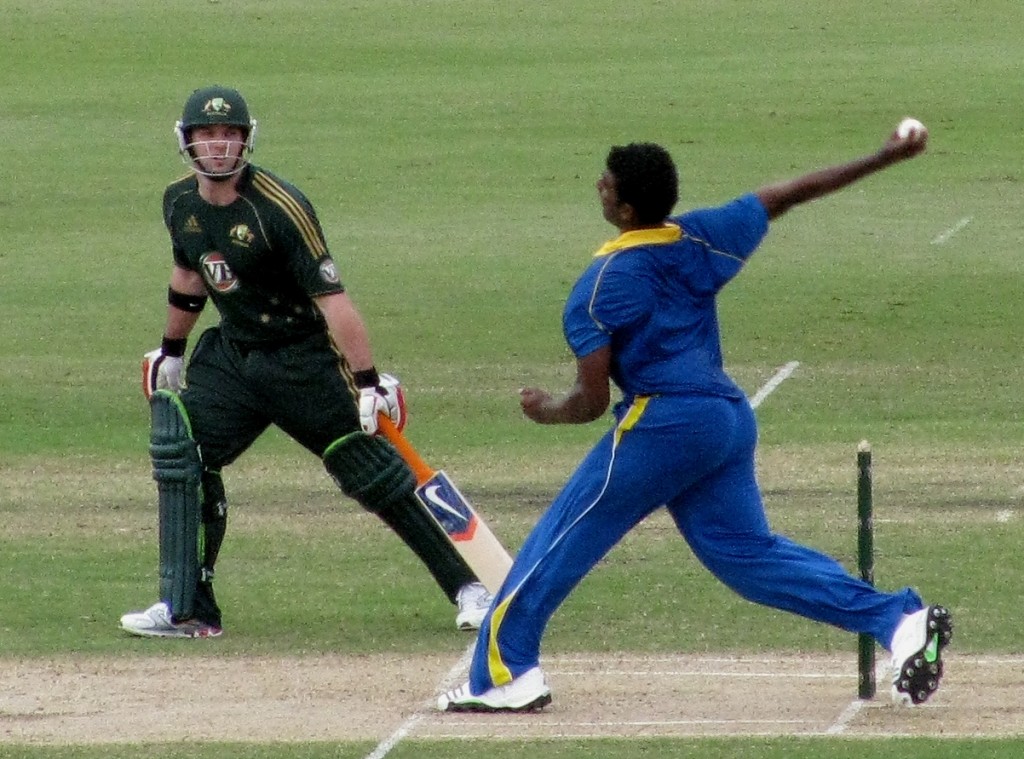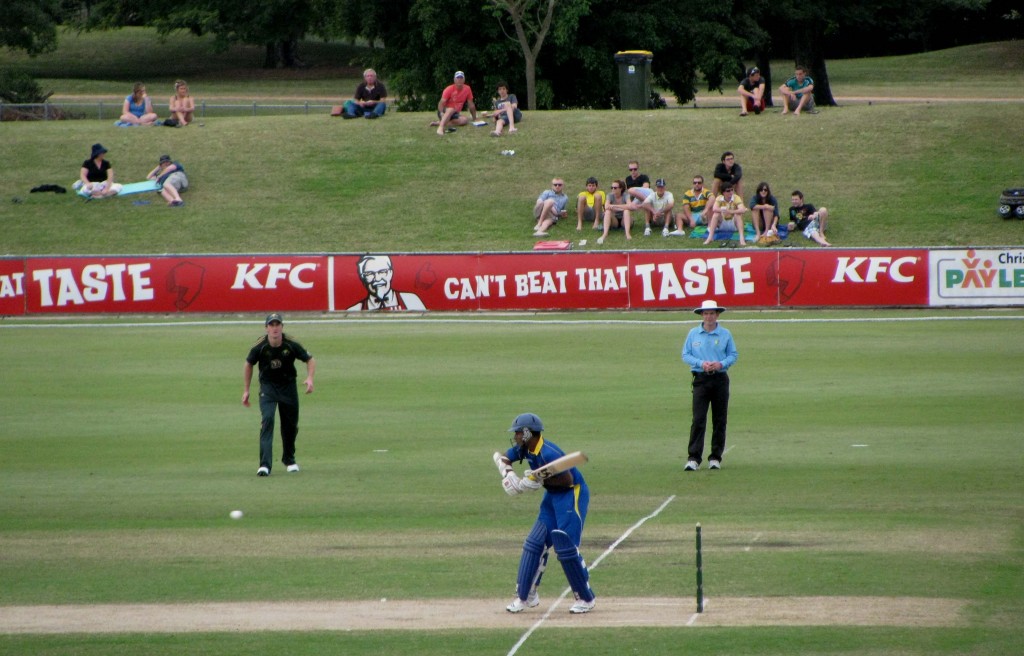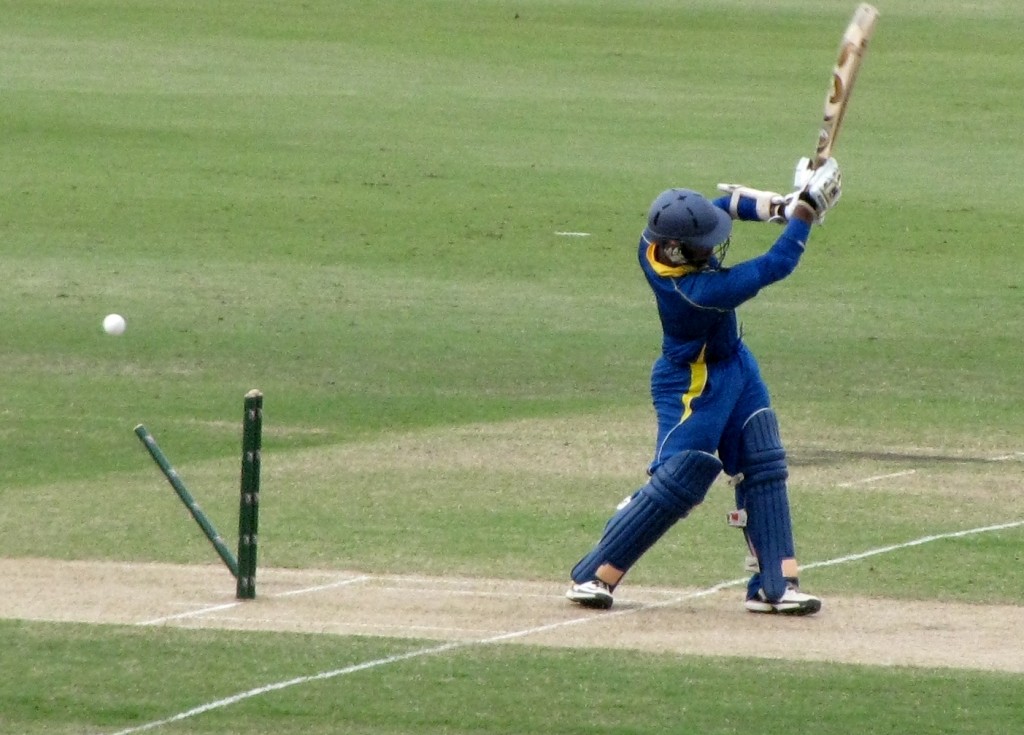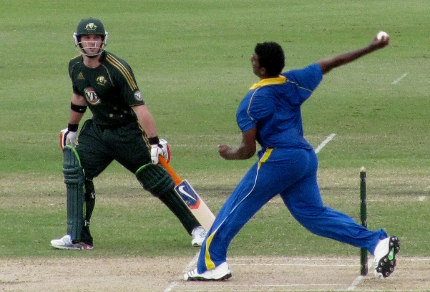
Australian Batsman & Sri Lankan Bowler (© Magi Nams)
Until this afternoon, I knew nothing about cricket. I had listened to excited ABC sports reporters refer to centuries and overs and wickets, but hadn’t a clue what those terms meant. Today, however, Vilis, Janis, and I delved into the world of cricket – a fiercely passionate Aussie sport, by all accounts – by attending a Twenty20 match between AustraliaA and Sri LankaA. The contest was held at the Tony Ireland Stadium in Pioneer Park, where we sat in shaded comfort and looked out over a closey-cropped oval of grass set against a backdrop of Riverway’s elegant, wide-crowned rain trees and, beyond them, the sparsely-treed hills footing Mount Stuart.

Sri Lankan Batsman in Action (© Magi Nams)
Hoping to mitigate our ignorance to a certain degree, Vilis had printed off Justine Larbalestier’s entertaining blog post “A Beginner’s Guide to Cricket,”1 which he and I perused studiously as the match began. We quickly caught the jist of the oval set-up – the thick, white rope marking the boundary (a ball hit to the rope would earn four runs, while a ball hit over it would earn six), the central pitch with its two stumps or wickets, one at each end, and the white line or crease marking the safe zone for the batsman as well as the foot limit for the bowlers, who repeatedly sprinted toward the crease and hurled a baseball-sized white ball toward the wicket at the opposite end of the pitch. An ellipse of white spots on the short grass outside of the pitch delimited an infield from an outfield. A helpful spectator seated beside Vilis explained that fewer fielders are allowed in the huge outfield during the early part of each team’s batting, but more can move to the outfield later in the batting.
Australia batted first, with two green-suited batsmen up against eleven royal-blue-suited Sri Lankan players (five in outer field, five in inner field, one bowler). In cricket, the batter’s job is two-fold – to protect the wicket or stump, with its wooden bails balanced on top the stakes, and to score runs. When one of the two batsmen hit a bowled ball, he and the other batsman usually exchanged places, scoring a run. Sometimes the two ran back again, upping the score by two runs. Unlike in baseball, the batsmen didn’t have to run when they hit the ball, and unlike in baseball, hit balls in any direction were allowed, so there were no foul balls called. That made it very difficult for fielders, who had to attempt to cover huge swathes of the oval and often failed to intercept the hit ball before it reached the boundary rope. However, as in baseball, a ball caught in the air before it touched the ground (hard on the hands, since the fielders, with the exception of the wicket keeper, wore no protective gloves) resulted in the batsman being called out.

Ball Hit Bail on Wicket (© Magi Nams)
Patiently, I waited for some adrenaline-pumping action on the oval, but it never transpired. The best we saw were several six-run hits, a handful of outs on caught balls, and one wicket stake hit by a bowled ball a Sri Lankan batsman missed, thus dislodging a bail (bad news). There was no mad race of batter to base, no three strikes and you’re out, no cagey base-stealing sprints, no reflex-popping fielding action focused within a much smaller diamond of turf. It all seemed rather measured. Certainly, the batsmen and bowlers battled in an endurance test (Australia’s Matthew Wade scored 80 runs (20 short of a century) before a fielder caught his high hit), but the rest of the crew must have been tempted to yawn on occasion. Rather than a contest of man versus the speed of the ball, which is definitely the case with baseball, cricket appeared to be a contest of ball versus the bails, which seemed to me to be a bit stingy on the human interaction component.
After 20 overs consisting of six bowls each, Australia completed their inning with a total of 176 runs. This took 90 minutes. Sri Lanka’s inning of 20 overs (the lightbulb came on regarding the origin of the match’s ‘Twenty20’ name) whiled away another hour and a half, during which I found it much more entertaining to study the crowd and local wildlife than to watch the game. Keen fans were dressed in gold shirts with AUSTRALIA on the backs. Some wore gold and green wigs and face paint. The smell of beer pervaded the air. Spectators made regular trips to the concession to purchase trays holding large plastic glasses of barley sandwiches. Loud music throbbed from mega-speakers at both ends of the oval, but quieted to silence for each bowl. Australian white ibises flew over the oval, and a laughing kookaburra perched on a tall pole, staring onto the field as if it was comtemplating exactly what was going on (in reality, it was probably scanning the turf for potential prey items). The crowd seemed a good-natured lot, clapping for the opposition when the Sri Lankan batsmen reached 50 runs, and again at 100 runs. Everyone simply seemed to be out for a good time. Late in the game, even the music took on a laid-back, even nostalgic ambience as the crowd sang cheerfully along with a drinking song and with “Skippy, The Bush Kangaroo.”

Cricket Fans (© Magi Nams)
I don’t even know how many runs the Sri Lankans scored in the end. I do know that they lost, and that they had a cluster of fans up behind us urging them to catch the Aussies. “Bloody good match!” one of the fans exclaimed when it was over. I would have described the match by using a different word beginning with b; however, as another helpful spectator told us, “It’s something you have to grow up with.”
While we exited the stadium in a jostling crowd, a young man almost spilled a drink on me, and I was surrounded by ruddy men completely unrelated to me. I was struck by a thought that had nothing whatsoever to do with cricket. My thought was that Australia doesn’t have nearly as many good-looking men as Canada does. Hold on – don’t hit me! I’ve lived in Oz for six months, not just a week or two, and I’ve done some traveling. Maybe it’s all the tattoos. Maybe it’s the effects of the beer or the sun, and it’s definitely just my humble opinion. Is this what cricket does to a person?
Reference:
1. Justine Larbalestier: writing, reading, eating, drinking, sport. A Beginner’s Guide to Cricket. 16 February, 2004. © 2003-2010. Accessed 12-July-2010. http://justinelarbalestier.com/blog/2004/02/16/a-beginners-guide-to-cricket/


